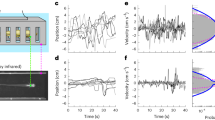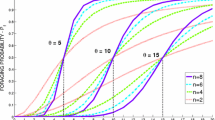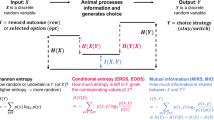Abstract
Various recent studies have suggested homeostasis and allostasis as the explanatory fundamentals behind physiological and behavioral regulation. Both are endogenous processes responsible for stabilizing the internal states of organisms, in which allostasis orchestrates multiple homeostatic systems. We propose that allostasis can also help organisms adapt to unresolved fluctuations presented by an unstable environment without learning-based predictions. We upgraded a previous computational model of allostatic control by dynamically weighing the agents’ motivational drives based on both situational interoceptive and exteroceptive signals. Our model was integrated as the control system of a simulated robot capturing thermoregulation and foraging as navigation profiles. Our results supported the re-organization of hierarchically-ordered drives as an essential feature of need-dependent adaptation that enhances internal stability.
Access this chapter
Tax calculation will be finalised at checkout
Purchases are for personal use only
Similar content being viewed by others
References
Hull, C.L.: Principles of behavior: an introduction to behavior theory. J. Philos. 40(20), 558 (1943)
Cannon, W.B.: The Wisdom of the Body. W. W. Norton & Co., pp. 177–201 (1932)
McEwen, B.S., Wingfield, J.C.: The concept of allostasis in biology and bio-medicine. Hormones and Behavior 43, pp. 2–15 (2003)
Vouloutsi, V., et al.: Towards the synthetic self: making others perceive me as an other. Journal of Behavioral Robotics (2015)
Vouloutsi, V., Lallée, S., Verschure, P.F.M.J.: Modulating behaviors using allostatic control. In: Conference on Biomimetic and Biohybrid Systems, pp. 287–298 (2013)
Guerrero, O., Verschure, P.F.M.J.: Robot regulatory behavior based on homeostatic and allostatic principles. In: Conference on Brain-Inspired Cognitive Architectures for Artificial Intelligence (2020)
Sterling, P., Eyer, J.: Allostasis: A new paradigm to explain arousal pathology. In: Handbook of life stress, cognition, and health (1988)
Ramsay, D.S., Woods, S.: C: clarifying the roles of homeostasis and allostasis in physiological regulation. Psychol. Rev. 121(2), 225–247 (2014)
Maslow, A.: A theory of human motivation. Psychol. Rev. 50(4), 370–396 (1943)
Sanchez-Fibla, M., et al.: Allostatic control for robot behavior regulation: a comparative rodent-robot study. Adv. Complex Syst. 13(3), 377–403 (2010)
Sanchez-Fibla, M., Bernardet, U., Verschure, P.F.M.J.: Allostatic control for robot behavior regulation: An extension to path planning. In: IEEE/RSJ International Conference on Intelligent Robots and Systems, pp. 1935–1942 (2010)
McEwen, B.S.: Physiology and neurobiology of stress and adaptation: central role of the brain. Psychol. Rev. 87(3), 873–904 (2007)
Houston, A., McFarland, D.: On the measurement of motivational variables. Animal Behavior 24, pp. 459–475 (1976)
Kenrick, D.T., Griskevicius, V., Neuberg, S., Schaller, M.: Renovating the pyramid of needs: Contemporary extensions built upon ancient foundations. Perspect. Psychol. Sci. 5(3), 292–314 (2010)
Corcoran, A.W., Hohwy, J.: Allostasis, interoception, and the free energy principle: Feeling our way forward. The interoceptive mind: From homeostasis to awareness 15, 272–292 (2018)
Wingfield, J.C.: The concept of allostasis: Coping with a capricious environment. J. Mammal. 86(2), 248–254 (2005)
Verschure, P.F.M.J., Duff, A.: Distributed Adaptive Control: Theory and Practice. Biologically Inspired Cognitive Architectures 1, 55–72 (2012)
Stanford Artificial Intelligence Laboratory et al.: Robotic Operating System (2018)
Bradski, G.: The OpenCV Library. Dr. Dobb’s Journal of Software Tools (2000)
Marcos, E., Sanchez-Fibla, M., Verschure, P.F.M.J.: The complementary roles of allostatic and contextual control systems in foraging tasks. Simulating Animal Behavior (SAB) LNCS Springer–Verlag (2010)
Freire, I.T., Amil, A.F., Vouloutsi, V., Verschure, P.F.M.J.: Towards sample-efficient policy learning with DAC-ML. Procedia Computer Science 190, 256–262 (2021)
Wallraff, G.: Aviannavigation: pigeon homing as a paradigm. Springer–Verlag (2005)
Author information
Authors and Affiliations
Corresponding author
Editor information
Editors and Affiliations
Rights and permissions
Copyright information
© 2022 The Author(s), under exclusive license to Springer Nature Switzerland AG
About this paper
Cite this paper
Ngo, T., Guerrero, O., Freire, I.T., Verschure, P.F.M.J. (2022). Homeostatic and Allostatic Principles for Behavioral Regulation in Desert Reptiles: A Robotic Evaluation. In: Hunt, A., et al. Biomimetic and Biohybrid Systems. Living Machines 2022. Lecture Notes in Computer Science(), vol 13548. Springer, Cham. https://doi.org/10.1007/978-3-031-20470-8_33
Download citation
DOI: https://doi.org/10.1007/978-3-031-20470-8_33
Published:
Publisher Name: Springer, Cham
Print ISBN: 978-3-031-20469-2
Online ISBN: 978-3-031-20470-8
eBook Packages: Computer ScienceComputer Science (R0)




